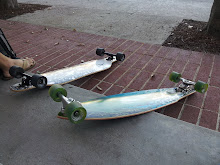The theme that runs across several of the readings this week is one that alters sound in order to create “art.” Kahn discusses the fact that sound is not really an object, which is why it makes sound art so hard to pin down, given that the visual hegemony treats art as objects. Ironically, Sterne has said that sound has become objectified and commodified in The Audible Past, but this line of thinking follows Kahn’s pointing out of the fact that sound is not necessarily something that is tangible. While Sterne and Kahn talk about sound differently. Sterne talks about it in a way in which sound as commodity has implications of class, power, status, economics, etc, whereas Kahn talks about the materiality of sound...a materiality that, before the inception of sound recording and reproducibility, did not exist. To experience sound, still, in the age of sound reproduction, is an exercise in ephemerality.
“When the industry comes up with a machine to record something, it has a very specific use, but the artist always tired to go beyond what the machine was designed for.” (Marclay, 344) There is a sort of subversion that happens here, using technology made by Powers That Be, but using them in a way that is not intended. This is similar to remix culture, and has tinges of copyright issues. You can use a CD player in any way you want, making them skip, scratching the CD player, etc in order to create something else - a work of sonic art. In remix, you use a piece of music, and remix it to create something else, yet in today’s digital world, these remix artists run into copyright issues. Marclay makes a rather poignant statement about records, about how he remembers when “the record changed from being this object to be respected, collected and stored for posterty, into a piece of plastic that had no more value than a coffee cup in the gutter.” (Marclay, 345) This conflict is particularly pertinent to the idea that sound is an object, but an ephemeral one rather than a tangible one.
There seems to be roughly three categories of aural signals that can be discerned from the readings this week - Cox highlights this a bit with his discussion of noise as unintended and the sonic unconsciousness. Then there is music, which has ideological and cultural expectations (this is what music is SUPPOSED to sound like - John Cage wonderfully pushes back on this notion with pieces like 4’33”, along with other composers like Boulez, Schnittke, Partch who push the conventional boundaries of music to a point where people may question whether their “music” is actually music). Then there is sound art, which seems to be, not exactly in the middle, but negotiates the position of music as the *only* type of art that can come of sound, and the questions of what “art” is, and how this differs from “music.” Sound art seems to play more with technology than music, as I had alluded to before, although I loathe to put boxes around these terms and make generalizations. But hopefully this is a useful way to start thinking about the distinctions, and the power structures that lay behind these concepts.
On another completely unrelated note, a Kit Kat commercial just came on. The breaking sound of the Kit Kat is completely fabricated, yet is THE selling point for the candy bar - not taste, not visual aesthetics, but sound.




No comments:
Post a Comment